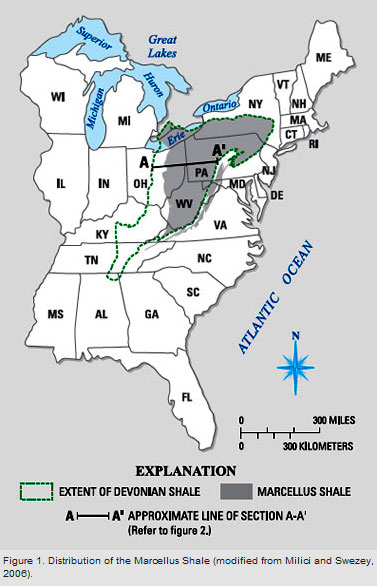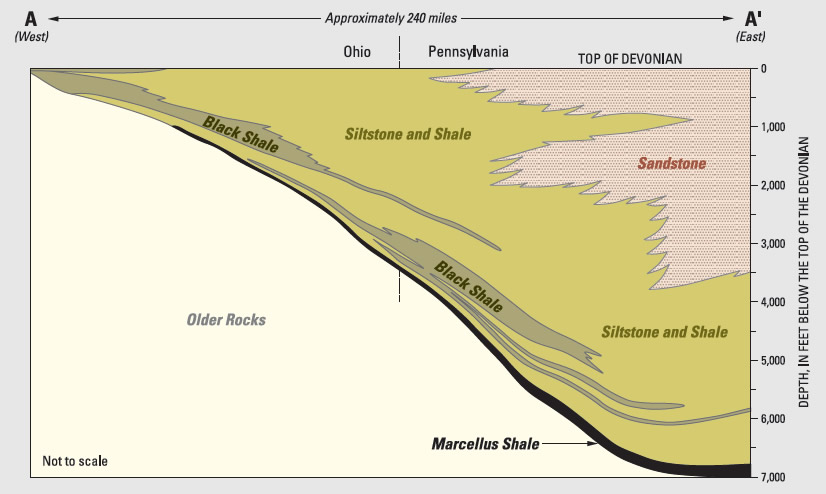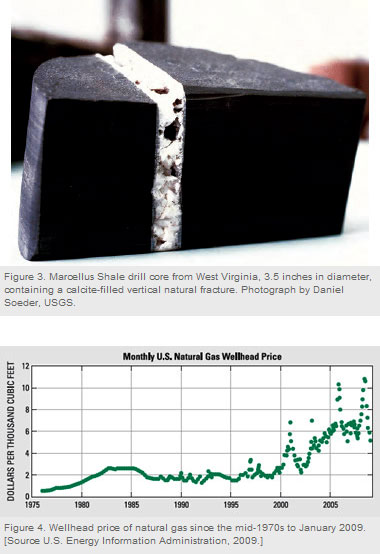Introduction
The Marcellus Shale is a sedimentary rock formation deposited over 350 million years ago in a shallow inland sea located in the eastern United States where the present-day Appalachian Mountains now stand (de Witt and others, 1993). This shale contains significant quantities of natural gas. New developments in drilling technology, along with higher wellhead prices, have made the Marcellus Shale an important natural gas resource.
The Marcellus Shale extends from southern New York across Pennsylvania, and into western Maryland, West Virginia, and eastern Ohio (fig. 1). The production of commercial quantities of gas from this shale requires large volumes of water to drill and hydraulically fracture the rock. This water must be recovered from the well and disposed of before the gas can flow. Concerns about the availability of water supplies needed for gas production, and questions about wastewater disposal have been raised by water-resource agencies and citizens throughout the Marcellus Shale gas development region. This Fact Sheet explains the basics of Marcellus Shale gas production, with the intent of helping the reader better understand the framework of the water-resource questions and concerns.
What is the Marcellus Shale?
The Marcellus Shale forms the bottom or basal part of a thick sequence of Devonian age, sedimentary rocks in the Appalachian Basin. This sediment was deposited by an ancient river delta, the remains of which now form the Catskill Mountains in New York (Schwietering, 1979).
The basin floor subsided under the weight of the sediment, resulting in a wedge-shaped deposit (fig. 2) that is thicker in the east and thins to the west. The eastern, thicker part of the sediment wedge is composed of sandstone, siltstone, and shale (Potter and others, 1980), whereas the thinner sediments to the west consist of finer-grained, organic-rich black shale, interbedded with organic-lean gray shale. The Marcellus Shale was deposited as an organic-rich mud across the Appalachian Basin before the influx of the majority of the younger Devonian sediments, and was buried beneath them.
Why is the Marcellus Shale an Important Gas Resource?
Organic matter deposited with the Marcellus Shale was compressed and heated deep within the Earth over geologic time, forming hydrocarbons, including natural gas. The gas occurs in fractures, in the pore spaces between individual mineral grains, and is chemically adsorbed onto organic matter within the shale (Soeder, 1988). To produce commercial amounts of natural gas from such fine-grained rock, higher permeability flowpaths must be intercepted or created in the formation. This is generally done using a technique called hydraulic fracturing or a “hydrofrac,” where water under high pressure forms fractures in the rock, which are propped open by sand or other materials to provide pathways for gas to move to the well. Petroleum engineers refer to this fracturing process as “stimulation.”
From the mid-1970s to early 1980s, the U.S. Department of Energy (DOE) funded the Eastern Gas Shales Project (EGSP) to develop new technology in partnership with industry that would advance the commercial development of Devonian shale gas (Schrider and Wise, 1980). Goals of the project included assessing the size of the resource, estimating recoverable gas, and determining the most effective technology for gas extraction. The EGSP shale stimulation experiments tested a wide variety of hydrofracs and other techniques. Results were somewhat uneven, and DOE concluded that stimulation alone was generally insufficient to achieve commercial shale gas production (Horton, 1982). It was suggested that better success could be obtained by targeting specific formations in specific locations. The EGSP results did indicate that if the hydraulic fractures were able to intercept sets of existing, natural fractures within the shale (fig. 3), a network of flowpaths could be created.
In the mid-1980s, the Institute of Gas Technology (IGT) in Chicago performed some laboratory analyses on EGSP shale samples (Soeder, 1988). Published IGT lab measurements found that a “gas-in-place” value for the Marcellus Shale at pressures representative of production depths may be as high as 26.5 standard cubic feet of gas per cubic foot of rock (Soeder, 1988). This greatly exceeded earlier gas-in-place estimates for Devonian shale by the National Petroleum Council (1980), which ranged from 0.1 to 0.6 standard cubic feet of gas per cubic foot of rock. Although IGT analyzed only one sample of Marcellus Shale, the large volumes of gas now being produced from this formation substantiate the early discovery of significant gas reserves.
In 2008, two professors at Pennsylvania State University and the State University of New York (SUNY) Fredonia estimated that about 50 TCF (trillion cubic feet) of recoverable natural gas could be extracted from the Marcellus Shale (Engelder and Lash, 2008). In November 2008, on the basis of production information from Chesapeake Energy Corporation, the estimate of recoverable gas from the Marcellus Shale was raised to more than 363 TCF (Esch, 2008). The United States uses about 23 TCF of natural gas per year (U.S. Energy Information Administration, 2009), so the Marcellus gas resource may be large enough to supply the needs of the entire Nation for roughly 15 years at the current rates of consumption.
Why is the Marcellus Shale Being Developed Now?
Low prices for natural gas, and ineffective production technology did little to spark interest in Devonian shale gas in the 1990s, despite the publication of the IGT Marcellus gas-in-place estimates. Two factors working together have promoted the current high levels of interest in the Marcellus Shale. First, wellhead prices for gas have risen from values of less than $2.00 per MCF (thousand cubic feet) in the 1980s (fig. 4) to a peak of $10.82 per MCF in the summer of 2008 (U.S. Energy Information Administration, 2009). Although prices had declined to $5.15 per MCF in January 2009 due to the economic downturn, they are still substantially higher than a decade earlier.
The second factor that spurred interest in the development of the Marcellus Shale is a new application of an existing drilling technology known as directional drilling, which involves steering a downhole drill bit in a direction other than vertical. An initially vertical drillhole is slowly turned 90 degrees to penetrate long horizontal distances, sometimes over a mile, through the Marcellus Shale bedrock. Hydraulic fractures are then created into the rock at intervals from the horizontal section of the borehole, allowing a substantial number of high-permeability pathways to contact a large volume of rock (fig. 5). According to Range Resources (2008), one of the first major horizontal drillers of Marcellus Shale, these wells typically produce gas at a rate of about 4 MMCF (million cubic feet) per day. Over its lifetime, each horizontal well on an 80-acre surface spacing can be expected to produce a total of about 2.5 BCF (billion cubic feet) of gas at an estimated production cost of $1.00 per MCF (Chernoff, 2008).
What are the Water-Resource Concerns About Developing Natural Gas Wells in the Marcellus Shale?
Substantial amounts of water are required for the drilling and stimulation of a Marcellus Shale gas well. Fluids recovered from the well, including the liquids used for the hydrofrac, and any produced formation brines, must be treated and disposed of properly. Three important water-resource concerns related to Marcellus Shale gas production are:
- supplying water for well construction without impacting local water resources,
- avoiding degradation of small watersheds and streams as substantial amounts of heavy equipment and supplies are moved around on rural roads, and
- determining the proper methods for the safe disposal of the large quantities of potentially contaminated fluids recovered from the wells.
These concerns are discussed in more detail in the following sections.
Water Supply
Drilling requires large amounts of water to create a circulating mud that cools the bit and carries the rock cuttings out of the borehole. After drilling, the shale formation is then stimulated by hydraulic fracturing, which may require up to 3 million gallons of water per treatment (Harper, 2008). Many regional and local water management agencies are concerned about where such large volumes of water will be obtained, and what the possible consequences might be for local water supplies. Under drought conditions, or in locations with already stressed water supplies, obtaining the millions of gallons needed for a shale gas well could be problematic. Drillers could face substantial transportation costs if the water has to be trucked in from great distances.
Similar shale gas operations in the Barnett Shale of Texas have obtained hydrofrac water largely from groundwater sources (Byrd, 2007). Water supply concerns over the Barnett Shale drilling have been brought up in the past (see, for example, Francis, 2007). Texas State and County agencies now closely monitor volumes of water used during drilling, and a consortium of Barnett Shale drilling companies have developed best management practices for water conservation, with the goal of keeping the pace of drilling and production activities within the bounds of sustainable water use. Similar steps have been discussed in Marcellus Shale gas production areas, but not yet fully implemented.
Large hydrofrac treatments often involve moving large amounts of equipment, vehicles, and supplies into remote areas. Transporting all of this to drill sites over rural Appalachian Mountain roads could potentially cause erosion, and threaten local small watersheds with sediment. Drill pad and pipeline construction also have the potential to cause similar problems. Of equal concern is the possibility for spills or leaks into water bodies as the fluids and chemical additives are transported and handled. Little is known about how a Marcellus Shale drilling “boom” might adversely affect the land, streams, and available water supplies in the Appalachian Basin. Even under current Marcellus gas production levels, complaints of rural road damage and traffic disruption from drilling equipment have been received, indicating that this could be a significant problem if carried out across thousands of active drill sites.
Wastewater Disposal
For gas to flow out of the shale, nearly all of the water injected into the well during the hydrofrac treatment must be recovered and disposed of. In addition to the problem of dealing with large bulk volumes of liquid waste, contaminants in the water may complicate wastewater treatment. Whereas the percentage of chemical additives in a typical hydrofrac fluid is commonly less than 0.5 percent by volume, the quantity of fluid used in these hydrofracs is so large that the additives in a three million gallon hydrofrac job, for example, would result in about 15,000 gallons of chemicals in the waste.
Hydrofrac fluids are often treated with proprietary chemicals to increase the viscosity to a gel-like consistency that enables the transport of a proppant, usually sand, into the fracture to keep it open after the pressure is released (fig. 6). The viscosity of these fluids then breaks down quickly after completion of the hydrofrac, so they can be easily removed from the ground. The chemical formulations required to achieve this are highly researched and closely guarded, and finding out exactly what is in these fluids may present a challenge. The data publicly available on Marcellus Shale hydrofrac treatments indicate that a slickwater frac works best on this formation (Harper, 2008). These types of hydrofracs employ linear gels and friction reducers in the water, and utilize only small amounts of proppant, relying instead on fracture surface roughness to hold it open (Rushing and Sullivan, 2007). The potential problems for local wastewater treatment facilities caused by proprietary chemical additives in hydrofrac fluid are unclear.
Along with the introduced chemicals, hydrofrac water is in close contact with the rock during the course of the stimulation treatment, and when recovered may contain a variety of formation materials, including brines, heavy metals, radionuclides, and organics that can make wastewater treatment difficult and expensive. The formation brines often contain relatively high concentrations of sodium, chloride, bromide, and other inorganic constituents, such as arsenic, barium, other heavy metals, and radionuclides that significantly exceed drinkingwater standards (Harper, 2008).
The current disposal practice for Marcellus Shale liquids in Pennsylvania requires processing them through wastewater treatment plants, but the effectiveness of standard wastewater treatments on these fluids is not well understood. In particular, salts and other dissolved solids in brines are not usually removed successfully by wastewater treatment, and reports of high salinity in some Appalachian rivers have been linked to the disposal of Marcellus Shale brines (Water and Wastes Digest, 2008). Another disposal option involves re-injecting the hydrofrac fluids back into the ground at a shallower depth. This is a common practice in the Barnett Shale production area of Texas, and has been utilized for some Marcellus wells drilled in West Virginia (Kasey, 2008). Concerns in Appalachian States about the possible contamination of drinking water supply aquifers has limited the practice of re-injecting Marcellus fluids, however. Another option might be to inject the waste fluid into deeper formations below the Marcellus Shale that are not used as aquifers, such as the Oriskany or Potsdam Sandstones. A third disposal process used in Texas places the wastewater into an open tank to evaporate. The solids that remain behind are then disposed of as dry waste. Although this may be an effective technique in the deserts of the American Southwest, its usefulness in the humid climate of the Appalachians is questionable. A systematic study of the options for Marcellus Shale waste fluid treatment, disposal, or recycling could help to determine the best available procedures.
Summary
Natural gas is an abundant, domestic energy resource that burns cleanly, and emits the lowest amount of carbon dioxide per calorie of any fossil fuel. The Marcellus Shale and other natural gas resources in the United States are important components of a national energy program that seeks both greater energy independence and greener sources of energy. Marcellus gas development has begun in the northern Appalachian Basin, with significant lease holdings throughout Pennsylvania, West Virginia, southern New York, western Maryland, and eastern Ohio. Because of questions related to water supply and wastewater disposal, however, many state agencies have been cautious about granting permits, and some states have placed moratoriums on drilling until these issues are resolved. At the same time, gas companies, drillers, and landowners are eager to move forward and develop the resource.
While the technology of drilling directional boreholes, and the use of sophisticated hydraulic fracturing processes to extract gas resources from tight rock have improved over the past few decades, the knowledge of how this extraction might affect water resources has not kept pace. Agencies that manage and protect water resources could benefit from a better understanding of the impacts that drilling and stimulating Marcellus Shale wells might have on water supplies, and a clearer idea of the options for wastewater disposal.
Source: http://geology.com/




